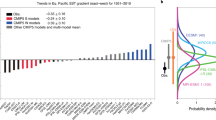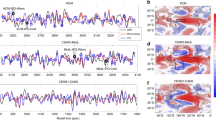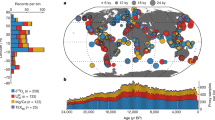Abstract
In light of mounting empirical evidence that planetary warming is well underway, the climate research community looks to palaeoclimate research for a ground-truthing measure with which to test the accuracy of future climate simulations. Model experiments that attempt to simulate climates of the past serve to identify both similarities and differences between two climate states and, when compared with simulations run by other models and with geological data, to identify model-specific biases. Uncertainties associated with both the data and the models must be considered in such an exercise. The most recent period of sustained global warmth similar to what is projected for the near future occurred about 3.3–3.0 million years ago, during the Pliocene epoch. Here, we present Pliocene sea surface temperature data, newly characterized in terms of level of confidence, along with initial experimental results from four climate models. We conclude that, in terms of sea surface temperature, models are in good agreement with estimates of Pliocene sea surface temperature in most regions except the North Atlantic. Our analysis indicates that the discrepancy between the Pliocene proxy data and model simulations in the mid-latitudes of the North Atlantic, where models underestimate warming shown by our highest-confidence data, may provide a new perspective and insight into the predictive abilities of these models in simulating a past warm interval in Earth history. This is important because the Pliocene has a number of parallels to present predictions of late twenty-first century climate.
This is a preview of subscription content, access via your institution
Access options
Subscribe to this journal
Receive 12 print issues and online access
$209.00 per year
only $17.42 per issue
Buy this article
- Purchase on Springer Link
- Instant access to full article PDF
Prices may be subject to local taxes which are calculated during checkout



Similar content being viewed by others
References
Randall, D. A. et al. in IPCC Climate Change 2007: The Physical Science Basis (eds Solomon, D. et al.) 589–662 (Cambridge Univ. Press, 2007).
Jansen, E. et al. in IPCC Climate Change 2007: The Physical Science Basis (eds Solomon, D. et al.) 433–497 (Cambridge Univ. Press, 2007).
Dowsett, H. et al. The PRISM3D paleoenvironmental reconstruction. Stratigraphy 7, 123–139 (2010).
Dowsett, H. J., Barron, J. & Poore, H. R. Middle Pliocene sea surface temperatures: A global reconstruction. Mar. Micropaleontol. 27, 13–25 (1996).
Dowsett, H. J., Chandler, M. A., Cronin, T. M. & Dwyer, G. S. Middle Pliocene sea surface temperature variability. Paleoceanography 20, 1–8 (2005).
Dowsett, H. J., Robinson, M. M. & Foley, K. M. Pliocene three-dimensional global ocean temperature reconstruction. Clim. Past. 5, 769–783 (2009).
Robinson, M. M., Dowsett, H. J., Dwyer, G. S. & Lawrence, K. T. Reevaluation of mid-Pliocene North Atlantic sea surface temperatures. Paleoceanography 23, PA3213 (2008).
Cronin, T. M. et al. Microfaunal evidence for elevated Pliocene temperatures in the Arctic Ocean. Paleoceanography 8, 161–173 (1993).
Barron, J. A. in Proc ODP, Sci Results Vol. 145 (eds Rea, D. K., Basov, I. A., Scholl, D. W. & Allan, J. F.) 43–53 (Ocean Drilling Program, CollegeStation, 1995).
Johnson, A. L. A. et al. Comparative sclerochronology of modern and mid-Pliocene (c. 3.5 Ma) Aequipecten opercularis (Mollusca, Bivalvia): An insight into past and future climate change in the north-east Atlantic region. Palaeogeogr. Palaeoclimatol. 284, 164–179 (2009).
Knowles, T., Taylor, P. D., Williams, M., Haywood, A. M. & Okamura, B. Pliocene seasonality across the North Atlantic inferred from cheilostome bryozoans. Palaeogeogr. Palaeoclimatol. 277, 226–235 (2009).
Valentine, A., Johnson, A. L. A., Leng, M. J., Sloane, H. J. & Balson, P. S. Isotopic evidence of cool winter conditions in the mid-Piacenzian (Pliocene) of the southern North Sea Basin. Palaeogeogr. Palaeoclimatol. 309, 9–16 (2011).
Dowsett, H. J. The development of a long-range foraminifer transfer function and application to Late Pleistocene North Atlantic climatic extremes. Paleoceanography 6, 259–273 (1991).
Waelbroeck, C. et al. Improving past sea surface temperature estimates based on planktonic fossil faunas. Paleoceanography 13, 272–283 (1998).
Dowsett, H. J. & Robinson, M. M. Application of the modern analogue technique (MAT) of sea surface temperature estimation to middle Pliocene North Pacific planktic foraminifer assemblages. Palaeontol. Electron. 1,http://palaeo-electronica.org/1998_1/dowsett/text.pdf (1998).
Dowsett, H. J. Faunal re-evaluation of mid-Pliocene conditions in the western equatorial Pacific. Micropaleontology 53, 447–456 (2007).
Hays, P. E., Pisias, N. G. & Roelofs, A. K. Paleoceanography of the eastern equatorial Pacific during the Pliocene: A high-resolution radiolarian study. Paleoceanography 4, 57–73 (1989).
Barron, J. A. Pliocene paleoclimatic interpretation of DSDP Site 580 (NW Pacific) using diatoms. Mar. Micropaleontol. 20, 23–44 (1992).
Barron, J. A. Diatom constraints on the position of the Antarctic Polar Front in the middle part of the Pliocene. Mar. Micropaleontol. 27, 195–213 (1996).
Barron, J. A. et al. in Paleoclimate and Evolution with Emphasis on Human Origins (eds Vrba, E. S., Denton, G. H., Partridge, T. C. & Burckle, L. H.) 197–212 (Yale Univ. Press, 1995).
Barron, J. A. Diatom constraints on sea surface temperatures and sea ice distribution during the middle part of the Pliocene. USGS Open-File Rep. 96–713, 1–45 (1996).
Cronin, T. M. & Dowsett, H. J. A quantitative micropaleontologic method for shallow marine paleoclimatology: Application to Pliocene deposits of the western North Atlantic Ocean. Mar. Micropaleontol. 16, 117–147 (1990).
Gladenkov, Y. B., Barinov, K. B., Basilian, A. E. & Cronin, T. M. Stratigraphy and paleoceanography of Pliocene deposits of Karaginsky Island, eastern Kamchatka, USSR. Quat. Sci. Rev. 10, 239–245 (1991).
Cronin, T. M. Pliocene shallow water paleoceanography of the North Atlantic Ocean based on marine ostracodes. Quat. Sci. Rev. 10, 175–188 (1991).
Ikeya, N. & Cronin, T. M. Quantitative analysis of Ostracoda and water masses around Japan: Application to Pliocene and Pleistocene paleoceanography. Micropaleontology 39, 263–281 (1993).
Lisiecki, L. E. & Raymo, M. E. A Pliocene–Pleistocene stack of 57 globally distributed benthic δ18O records. Paleoceanography 20, 1–17 (2005).
Wade, B. S., Pearson, P. N., Berggren, W. A. & Pälike, H. Review and revision of Cenozoic tropical planktonic foraminiferal biostratigraphy and calibration to the geomagnetic polarity and astronomical time scale. Earth Sci. Rev. 104, 111–142 (2011).
Shackleton, N. J., Crowhurst, S., Hagelberg, T., Pisias, N. G. & Schneider, D. A. in Proc ODP, Sci Results Vol. 138 (eds Pisias, N. G., Mayer, L. A., Janecek, T. R., Palmer-Julson, A. & van Andel, T. H.) 73–101 (Ocean Drilling Program, College Station, 1995).
Dowsett, H. J. & Poore, R. Z. Pliocene sea surface temperatures of the North Atlantic Ocean at 3.0 Ma. Quat. Sci. Rev. 10, 189–204 (1991).
Naish, T. et al. Obliquity-paced Pliocene West Antarctic ice sheet oscillations. Nature 458, 322–328 (2009).
Robinson, M. M. & Dowsett, H. J. ePRISM: A case study in multiple proxy and mixed temporal resolution integration. Stratigraphy 7, 177–187 (2010).
Dowsett, H. J. & Robinson, M. M. Stratigraphic framework for Pliocene paleoclimate reconstruction: The correlation conundrum. Stratigraphy 3, 53–64 (2006).
Dowsett, H. J. in Deep-Time Perspectives on Climate Change: Marrying the Signal from Computer Models and Biological Proxies (eds Williams, M., Haywood, A. M., Gregory, J. & Schmidt, D. N.) 459–480 (Geological Society of London, 2007).
Mastrandrea, M. D. et al. Guidance Note for Lead Authors of the IPCC Fifth Assessment Report on Consistent Treatment of Uncertainties (IPCC, 2010).
Ortiz, J. D. in Encyclopedia of Quaternary Science (eds Elias, S. A. et al.) 1692–1699 (Elsevier, 2007).
Hutson, W. H. The Agulhas Current during the Late Pleistocene: Analysis of modern faunal analogs. Science 207, 64–66 (1980).
Dowsett, H. J., Robinson, M. M., Stoll, D. K. & Foley, K. M. Mid-Piacenzian mean annual sea surface temperature analysis for data-model comparisons. Stratigraphy 7, 189–198 (2010).
Dowsett, H. J. et al. Sea surface temperatures of the mid-Piacenzian Warm Period: A comparison of PRISM3 and HadCM3. Palaeogeogr. Palaeoclimatol. 309, 83–91 (2011).
Zimmerman, H. B. et al. in Init Rpts DSDP Vol. 81 (eds Roberts, D. G. et al.) 861–875 (US Govt. Printing Office, 1984).
Curry, W. B. & Miller, K. G. in Proc ODP, Sci Results Vol. 108 (eds Ruddiman, W. et al.) 157–166 (Ocean Drilling Program, 1989).
Dowsett, H. J. & Poore, R. Z. A new planktic foraminifer transfer function for estimating Pliocene–Holocene paleoceanographic conditions in the North Atlantic. Mar. Micropaleontol. 16, 1–23 (1990).
Jenkins, D. G. & Houghton, S. D. et al. in Proc ODP, Sci Results Vol. 111 (ed. Becker, K.) 289–293 (Ocean Drilling Program, College Station, 1989).
Keany, J. Paleoclimatic trends in early and middle Pliocene deep-sea sediments of the Antarctic. Mar. Micropaleontol. 3, 35–49 (1978).
Peirce, J. et al. Proc ODP, Init Repts 121, 191–236 (Ocean Drilling Program, College Station, 1989).
Haywood, A. et al. Pliocene Model Intercomparison Project (PlioMIP): Experimental design and boundary conditions (Experiment 2). Geosci. Model Dev. 4, 571–577 (2011).
Reynolds, R. W. & Smith, T. M. A high-resolution global sea surface temperature climatology. J. Clim. 8, 1571–1583 (1995).
Acknowledgements
H.J.D., M.M.R., D.K.S. and K.M.F. acknowledge the continued support of the US Geological Survey Climate and Land Use Change Research and Development Program; C.R.R. thanks the US Geological Survey Mendenhall Postdoctoral Fellowship Program; H.J.D., M.M.R. and M.A.C. thank the US Geological Survey John Wesley Powell Center for Analysis and Synthesis; M.A.C. acknowledges support from the NASA Climate Modelling Program. A.M.H. acknowledges financial support from the European Research Council under the European Union’s Seventh Framework Programme (FP7/2007-2013)/ERC grant agreement no. 278636. D.J.H. undertook his contribution as part of a Leverhulme Early Career Fellowship (ECF-2011-205), co-financially supported by the British Geological Survey and National Centre for Atmospheric Science; D.J.L. and F.J.B. acknowledge the Natural Environment Research Council grant NE/H006273/1. B.L.O-B. and N.A.R. recognize the National Center for Atmospheric Research is sponsored by the US National Science Foundation and computing resources were provided by the Climate Simulation Laboratory at the National Center for Atmospheric Research’s Computational and Information Systems Laboratory sponsored by the National Science Foundation and other agencies. This research used samples and/or data provided by the Integrated Ocean Drilling Program. This is a product of the PRISM Project and the Pliocene Model Intercomparison Project.
Author information
Authors and Affiliations
Contributions
H.J.D., M.M.R., K.M.F. and D.K.S. developed the mid-Piacenzian SST-verification data set and carried out the data–model comparison. H.J.D., M.M.R. and C.R.R. designed and completed the confidence assessments. D.J.L., F.J.B., A.M.H., M.A.C., W-L.C., A.A-O., B.L.O-B. and N.A.R. carried out the general circulation model simulations and analysis. H.J.D., M.M.R., A.M.H. and B.L.O-B. were involved in the study design. A.M.H., D.J.H. and A.M.D. carried out the comparison of model performance for the pre-industrial versus Pliocene. All authors discussed the results and commented on the manuscript.
Corresponding author
Ethics declarations
Competing interests
The authors declare no competing financial interests.
Supplementary information
Rights and permissions
About this article
Cite this article
Dowsett, H., Robinson, M., Haywood, A. et al. Assessing confidence in Pliocene sea surface temperatures to evaluate predictive models. Nature Clim Change 2, 365–371 (2012). https://doi.org/10.1038/nclimate1455
Received:
Accepted:
Published:
Issue Date:
DOI: https://doi.org/10.1038/nclimate1455
This article is cited by
-
Antiphase change in Walker Circulation between the Pacific Ocean and the Indian Ocean during the Last Interglacial induced by interbasin sea surface temperature anomaly contrast
Climate Dynamics (2024)
-
Satellite-observed strong subtropical ocean warming as an early signature of global warming
Communications Earth & Environment (2023)
-
Changes in Sahel summer rainfall in a global warming climate: contrasting the mid-Pliocene and future regional hydrological cycles
Climate Dynamics (2023)
-
Speaking to the past
Scientific Data (2020)
-
Reduced Atlantic variability in the mid-Pliocene
Climatic Change (2020)



